Table of Contents
Mobility plays a crucial role in fitness, particularly in Crossfit, where it significantly enhances athletic performance and contributes to overall health. Mobility refers to the ability of a joint to move freely through its full range of motion and is essential for performing the high-intensity, complex movements characteristic of Crossfit. Improved mobility not only helps athletes perform exercises more effectively but also reduces the risk of injuries.
Incorporating targeted mobility exercises into a Crossfit routine is vital for achieving peak performance and safety. These exercises enhance joint mobility and muscle flexibility, crucial for efficient execution of various Crossfit movements and for avoiding common injuries associated with the sport.
“Enhancing your mobility can significantly improve your Crossfit performance.”
This article will explore the importance of mobility in Crossfit, providing practical advice on how to enhance it effectively. By understanding mobility’s role, learning about the most effective exercises, exploring stretching’s benefits, designing balanced workouts, and measuring mobility progress, readers will gain comprehensive insights into optimizing their Crossfit training.
- Understanding Mobility in Crossfit: Explains the concept of mobility within Crossfit and its importance for all levels of athletes.
- Top Crossfit Exercises to Improve Mobility: Describes exercises that improve joint mobility, detailing their benefits for performance and injury prevention.
- The Role of Stretching in Crossfit Routines: Details the different types of stretching and their benefits for mobility in Crossfit.
- Crossfit Workouts for Flexibility and Strength: Discusses how to create workouts that balance strength training and flexibility exercises.
- Measuring Progress in Mobility with Crossfit: Outlines tools and techniques for measuring mobility improvements and setting realistic training goals.
By enhancing mobility, athletes not only perform better but also move more effectively, ensuring a healthier and more sustainable approach to fitness. This introduction sets the stage for a detailed discussion on mobility in Crossfit, encouraging readers to integrate the upcoming insights and techniques into their fitness routines to improve both their Crossfit performance and overall health.
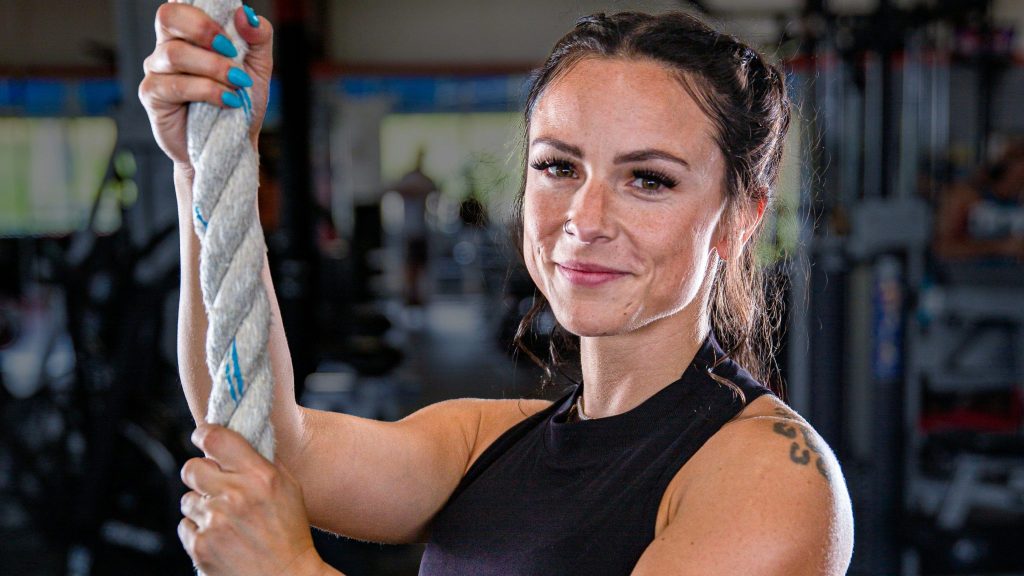
Understanding Mobility in Crossfit
Mobility is crucial in Crossfit, significantly enhancing athletic performance and contributing to safety. As athletes participate in Crossfit’s high-intensity and varied exercises, optimal mobility is essential for accurately and efficiently performing movements. This section delves into the role of mobility in improving Crossfit workouts, preventing injuries, and distinguishing it from flexibility, emphasizing its necessity for all Crossfit participants.
Importance of Mobility for Crossfit Performance
In Crossfit, mobility directly affects every facet of performance. Successful execution of heavy lifts and complex gymnastic movements requires the ability to move joints through a full range of motion with control and strength. Effective mobility ensures that athletes can maintain correct positions necessary for optimal power output and technical precision, crucial for improving times and scores in Crossfit workouts.
Incorporating specific mobility exercises can enhance an athlete’s capacity to handle the physical demands of various Crossfit workouts. For instance, improved hip and ankle mobility can lead to deeper squats, reduced risk of compensatory injuries, and more powerful lifts. Enhanced shoulder mobility is vital for safely executing overhead presses and handstands, thus improving Crossfit performance through targeted mobility exercises is about enhancing movement quality during workouts.
“Effective mobility ensures that athletes can maintain correct positions necessary for optimal power output and technical precision, crucial for improving times and scores in Crossfit workouts.”
Impact of Mobility on Injury Prevention in Crossfit
Mobility is a key factor in preventing injuries in the Crossfit community. Restricted mobility can lead to compensatory movement patterns, where the body tries to fulfill the demands of an exercise without adequate joint motion. This often causes excessive stress on muscles, tendons, and ligaments, leading to overuse injuries or acute damage. For example, limited thoracic spine mobility can result in improper overhead lifting techniques, increasing the risk of shoulder injuries.
Incorporating mobility drills into daily workouts can progressively improve joint function, which correlates with a lower risk of injuries. This strategy not only keeps athletes safe but also ensures continuous training progress without setbacks from avoidable injuries.
Overview of Mobility vs. Flexibility in Crossfit
Flexibility and mobility, while often used interchangeably, refer to different aspects of fitness. Flexibility is the muscle’s ability to stretch temporarily, while mobility is the joint’s ability to move freely and stably through its range of motion. This distinction is crucial in Crossfit, as enhanced mobility involves both muscle flexibility and joint movement functionality.
Understanding the differences between mobility and flexibility allows Crossfit athletes to more accurately focus on their training needs. An athlete may be flexible enough to perform a deep split but may lack the hip and core stability for a heavy squat. Crossfit demands dynamic mobility, which combines strength, control, and flexibility to efficiently and safely perform complex movements.
| Injury Type | Common Causes | Prevention Through Mobility |
|---|---|---|
| Shoulder Injuries | Poor overhead technique | Improved shoulder mobility |
| Knee Injuries | Inadequate squat form | Enhanced hip and ankle mobility |
| Lower Back Pain | Improper lifting form | Increased lumbar and pelvic mobility |
Understanding the distinct role of mobility, as compared to flexibility, helps practitioners adopt targeted exercises that effectively enhance their range of motion. Continue reading to discover specific exercises and routines that can improve your mobility, thereby boosting your overall Crossfit performance. This knowledge is fundamental in advancing your fitness journey in Crossfit.

Top Crossfit Exercises to Improve Mobility
In Crossfit, mobility is essential for achieving peak performance and maintaining safety during workouts. This section describes the best exercises for improving mobility in Crossfit athletes, focusing on squats, lunges, shoulder presses, and the incorporation of Olympic lifts. Each exercise is selected for its effectiveness in promoting joint health, increasing flexibility, and enhancing overall functional fitness.
Key Mobility Exercises: Squats, Lunges, and Shoulder Presses
Squats, lunges, and shoulder presses are essential exercises in Crossfit that significantly improve mobility. Squats increase lower body strength and flexibility, particularly beneficial for the hips, knees, and ankles. Regularly performing squats not only builds muscle but also enhances range of motion and stability, essential for safe and effective execution of complex movements.
Lunges target the hip flexors, which are vital for maintaining lower body mobility. They improve balance and coordination, facilitating smoother and more efficient transitions between exercises in a Crossfit workout.
Shoulder presses improve upper body mobility, focusing on the shoulders and upper back. This exercise enhances the stability and range of motion of the shoulder joints, crucial for safely performing overhead lifts and other gymnastic movements in Crossfit that require substantial upper body strength and flexibility.
“Olympic lifts require a complex range of motion from multiple joints simultaneously, enhancing functional mobility and dynamic strength essential for Crossfit.”
Benefits of Incorporating Olympic Lifts for Mobility
Olympic lifts, such as the snatch and clean and jerk, effectively improve overall body mobility. These lifts necessitate a complex range of motion from multiple joints simultaneously, which aids in enhancing functional mobility and dynamic strength. These are fundamental for maintaining balance and coordination during the intense, varied movements that Crossfit workouts demand.
Olympic lifts also enhance proprioceptive skills—the body’s ability to sense movement within joints and muscle fibers. Including Olympic lifts in mobility training ensures that athletes can handle rapid, varied movements efficiently, reducing the risk of injury.
Mobility Circuits and Their Effectiveness
Mobility circuits combine several mobility-focused exercises in a sequence, effectively improving range of motion and reducing stiffness. These circuits usually include a mix of dynamic stretches, isolation exercises, and compound movements that engage multiple joints and muscle groups.
- Dynamic leg swings: Enhance leg mobility and warm up key muscle groups.
- Inchworms: Improve core strength and flexibility in the hamstrings and back.
- Deep lunge holds: Increase hip flexor and thigh flexibility, crucial for lower body mobility.
Regular incorporation of mobility circuits into training can significantly enhance an athlete’s ability to perform Crossfit workouts more efficiently and with a lower risk of injury.
Including specific exercises like squats, lunges, shoulder presses, and Olympic lifts in regular Crossfit routines greatly enhances an athlete’s mobility. Furthermore, the strategic use of mobility circuits can improve an athlete’s flexibility, stability, and overall performance, leading to safer and more effective workouts. As Crossfit continues to evolve, the focus on mobility exercises will undoubtedly remain crucial in helping athletes achieve their highest potential. Continue exploring the next sections to learn how stretching and proper workout design can complement these exercises for optimal mobility in Crossfit.
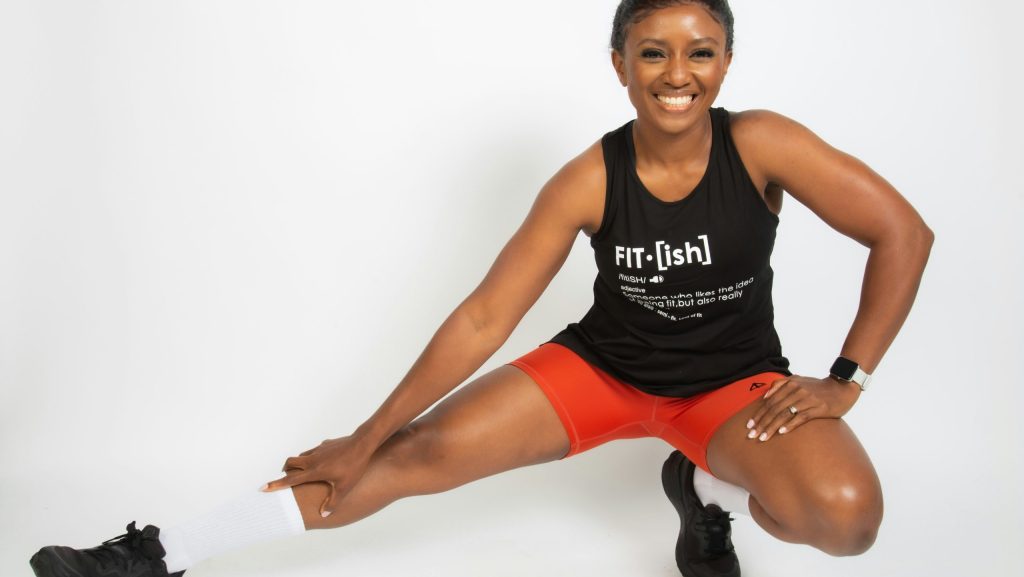
The Role of Stretching in Crossfit Routines
Stretching is an integral component of Crossfit training, essential not only for enhancing flexibility but also for boosting performance and reducing the risk of injuries. This section delves into the various types of stretching—dynamic, static, and proprioceptive neuromuscular facilitation (PNF)—each serving distinct purposes in preparing athletes for workouts and aiding in recovery.
Types of Stretches Important for Crossfit (Dynamic, Static, PNF)
Dynamic stretching is crucial for Crossfit athletes as it prepares the body for intense activity. This type of stretching involves active movements where muscles go through their full range of motion. It is particularly beneficial before workouts to increase blood flow to muscles, enhance elasticity, and reduce the risk of injuries. Examples of dynamic stretches include leg swings, arm circles, and lunges with a twist, which activate and prepare the muscles for the demands of Crossfit training.
Static stretching involves extending a muscle to its furthest point and then holding that position for a certain period. It is most effective post-workout to help cool down the body and aid in muscle recovery. Static stretches improve overall flexibility, reduce muscle tightness, and alleviate post-exercise soreness. Common static stretches include toe touches, held squats, and stretches targeting the hamstrings and shoulders.
“Proprioceptive Neuromuscular Facilitation (PNF) stretching is highly effective in increasing flexibility and muscular strength because it facilitates muscular inhibition.”
Proprioceptive Neuromuscular Facilitation (PNF) stretching is an advanced form of flexibility training that combines stretching and contracting the muscle group being targeted. This method is highly effective in increasing flexibility and enhancing muscular strength because it promotes muscular inhibition. PNF stretching is particularly useful for athletes looking to increase their range of motion and improve muscular function, often requiring a partner or coach to provide resistance.
Best Times to Stretch in a Crossfit Session (Pre-workout, Post-workout)
The timing of stretching in a Crossfit session can significantly influence an athlete’s performance and recovery. Dynamic stretches are best performed at the beginning of a session to prepare the muscles for the physical demands ahead. These stretches help increase blood flow, enhance muscular elasticity, and reduce the risk of injuries.
After the workout, static stretching is essential for cooling down the body and aiding muscle recovery. Post-exercise static stretches help to elongate and relax the muscles, prevent stiffness, and reduce soreness. This type of stretching also helps in gradually lowering the heart rate and promoting blood circulation, essential for lactate removal from the muscles.
| Type of Stretching | Timing in Routine | Primary Benefits |
|---|---|---|
| Dynamic Stretching | Pre-workout | Increases blood flow, enhances muscular elasticity, reduces injury risk |
| Static Stretching | Post-workout | Aids muscle recovery, reduces stiffness, helps cool down the body |
Long-Term Benefits of a Consistent Stretching Routine
Adopting a consistent stretching routine provides numerous long-term benefits for Crossfit athletes. Regular stretching not only improves flexibility but also enhances muscular balance and posture, vital for performing Crossfit exercises correctly and safely. It also leads to better joint mobility, increased strength, and a reduced risk of injuries.
Additionally, a regular stretching regimen improves neuromuscular coordination, enhancing the nervous system’s ability to control muscle movements. This efficiency significantly boosts an athlete’s capacity to perform complex movements at higher intensities. Athletes who integrate stretching consistently into their training experience improved recovery rates, less pain, and greater overall athletic performance.
Integrating specific stretching techniques into Crossfit routines delivers substantial benefits. Recognizing the proper application of dynamic, static, or PNF stretches maximizes these advantages, enhancing performance, flexibility, and injury prevention. A tailored stretching regimen supports Crossfit athletes in maintaining peak performance levels and accelerating recovery. Continue exploring subsequent sections to discover more about designing effective workouts and measuring mobility progress to further enhance your Crossfit journey.
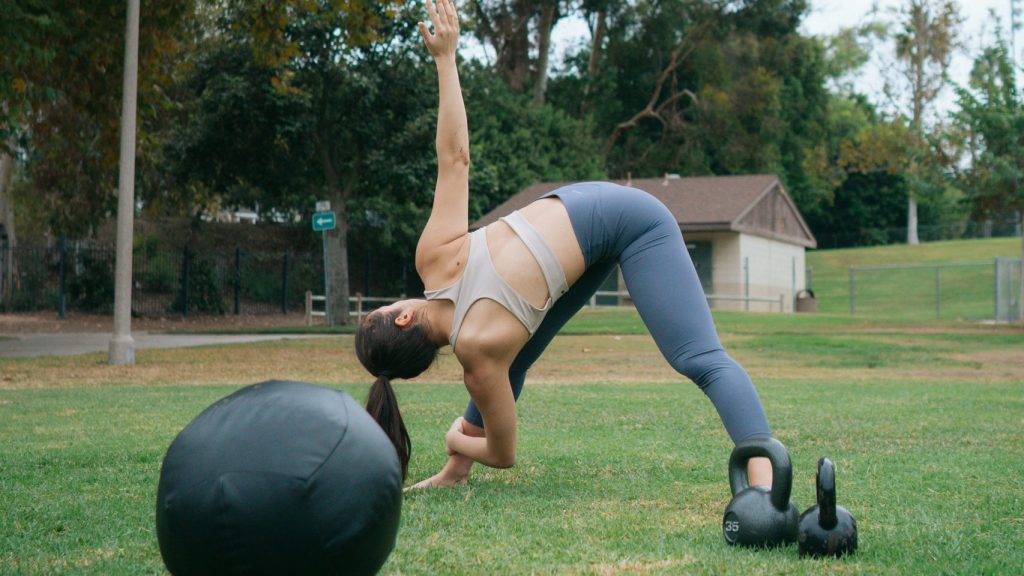
Crossfit Workouts for Flexibility and Strength
Flexibility and strength are both essential elements of a comprehensive Crossfit regimen. Integrating these components successfully can lead to well-rounded athletes who excel in both the range of motion and power output. This section explores effective strategies for designing balanced Crossfit workouts that enhance both flexibility and strength, aiming to help athletes achieve optimal physical fitness.
Designing Balanced Crossfit Programs
A strategic approach to integrating both strength and flexibility training is crucial for balanced Crossfit programs. While strength training builds muscle and enhances metabolic rate, flexibility training maintains joint health and prevents injuries. Effective program designs should incorporate elements such as weightlifting for strength alongside yoga or dynamic stretching routines for flexibility. Structuring each session to start with dynamic stretches prepares muscles and joints for the intense strength training exercises that follow, ensuring that athletes develop strength without losing mobility or increasing injury risk.
A typical balanced Crossfit session might start with 10 minutes of dynamic stretching focused on mobilizing the hips, shoulders, and back—areas heavily engaged during Crossfit workouts. Following the warm-up, the workout could progress to strength training exercises such as deadlifts or squats, fundamental for building lower body strength. By integrating exercises that emphasize flexibility, athletes can ensure that gains in muscle mass and strength do not compromise their mobility.
“Integrating exercises like kettlebell swings and overhead presses within a regimen that also emphasizes flexibility ensures that gains in muscle mass and strength do not reduce mobility.”
Examples of Workouts Combining Strength and Flexibility
Combining strength and flexibility in workouts can significantly enhance overall fitness. For instance, a circuit that includes kettlebell swings, overhead presses, and yoga poses can be particularly effective. Kettlebell swings develop core and lower body strength while also improving flexibility through the dynamic nature of the swings. Overhead presses build upper body strength, particularly targeting the shoulders and arms. Incorporating yoga poses such as the downward dog or warrior poses between sets helps maintain muscle elasticity and joint mobility.
Another productive workout combines barbell squats with Pilates. Performing a set of barbell squats followed by Pilates exercises like the Pilates hundred enhances lower body strength while improving core stability and flexibility. This combination allows muscular and neuromuscular systems to develop harmoniously, enhancing athletic performance and reducing injury risks.
Role of Recovery in Enhancing Flexibility
Recovery plays a critical role in maintaining and improving flexibility. Incorporating recovery techniques such as foam rolling, massage, and gentle stretching on rest days can significantly enhance muscle relaxation and tissue elasticity, crucial for maintaining flexibility gains made through training.
- Foam rolling: Helps alleviate muscle tightness and improve tissue elasticity.
- Massage: Facilitates muscle relaxation and speeds up recovery.
- Gentle stretching on rest days: Maintains flexibility and aids in the recovery process.
Including active recovery sessions that feature light activities like swimming or cycling can also benefit flexibility. These activities keep the muscles engaged without the intensity of regular Crossfit workouts, promoting blood circulation and nutrient delivery to muscle tissues, which aids recovery and flexibility.
Creating workouts that effectively combine strength and flexibility results in more robust and adaptable athletes. The integration of targeted recovery techniques further supports this development by ensuring that athletes can continue to perform at their best. For more insights into how these practices contribute to overall athletic performance and how to measure their effectiveness, continue exploring the subsequent sections. This holistic approach not only enhances individual workouts but also contributes to the long-term success and health of Crossfit athletes.
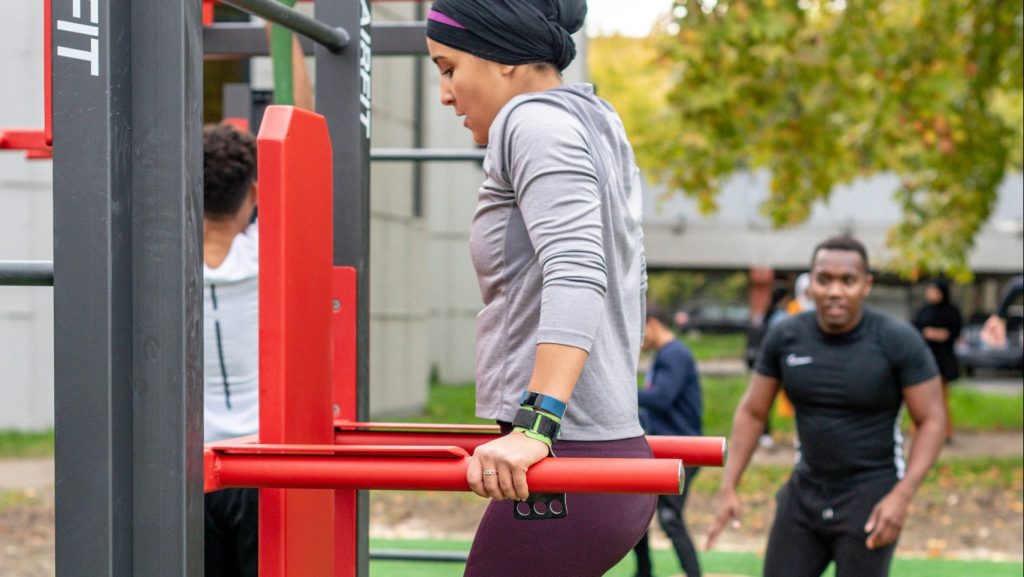
Measuring Progress in Mobility with Crossfit
Mobility is a critical component of Crossfit, vital for both enhancing performance and reducing the risk of injury. Accurately measuring mobility progress is essential for Crossfit athletes who aim to continuously improve their capabilities. This section delves into the tools and techniques used to assess mobility, how to set realistic goals, and provides examples of successful mobility enhancement.
Tools and Techniques to Measure Mobility Improvements
To accurately measure mobility improvements in Crossfit athletes, several tools and techniques are employed. Range of motion tests, such as the overhead squat assessment or the functional movement screen, are standard methods used to evaluate an athlete’s mobility across various joints. These tests are crucial for identifying mobility restrictions and tracking improvements over time.
Technological tools like motion capture systems provide detailed insights into an athlete’s movement patterns, offering precise measurements that manual observation cannot achieve. Additionally, simple tools like goniometers or inclinometers measure joint angles, providing quantitative data on mobility enhancements. Regular application of these tools allows coaches and athletes to customize their training programs to specifically target mobility limitations and monitor progress effectively.
“Targeted mobility drills, including dynamic stretches and PNF stretching, have significantly improved performance in snatches and overhead squats for many athletes.”
Setting Realistic Mobility Goals in Crossfit Training
Setting realistic mobility goals is crucial for effective progress in Crossfit. These goals should be specific, measurable, achievable, relevant, and time-bound (SMART). For example, if an athlete struggles with achieving full depth in a squat due to limited ankle mobility, a realistic goal might be to increase ankle dorsiflexion by five degrees within three months.
Athletes and coaches should base these goals on initial mobility assessments and adjust them as improvements occur. Integrating these goals into the overall training plan, with dedicated time for mobility exercises and regular assessments to track progress, ensures that mobility enhancements contribute directly to better performance and reduced injury risk.
- Increase ankle dorsiflexion: Aim to improve by 5 degrees within three months.
- Enhance shoulder mobility: Target achieving full range of motion with no pain within six months.
- Improve hip flexibility: Focus on deepening squat depth by 10 degrees over four months.
Case Studies or Examples of Successful Mobility Enhancement
Examining case studies or real-life examples provides valuable insights into successful mobility enhancement strategies. For instance, consider a Crossfit athlete who incorporated targeted mobility drills to improve hip and shoulder mobility, significantly enhancing their performance in snatches and overhead squats over six months. These drills included dynamic stretches, PNF stretching, and strength exercises focused on mobility.
Another example involves an athlete who combined yoga with regular mobility assessments to enhance overall flexibility and performance in Crossfit competitions. This comprehensive approach not only improved their range of motion but also contributed to better muscle recovery and reduced injury occurrences.
Measuring and enhancing mobility in Crossfit is crucial for athletes aiming for peak performance and sustained health. By using effective tools for mobility assessment, setting informed goals, and learning from successful case studies, athletes can ensure continuous improvement. This not only enhances their daily workout performance but also contributes to long-term success and injury prevention in Crossfit. Continue to explore additional resources and training methods to further enhance your mobility and overall Crossfit capabilities.
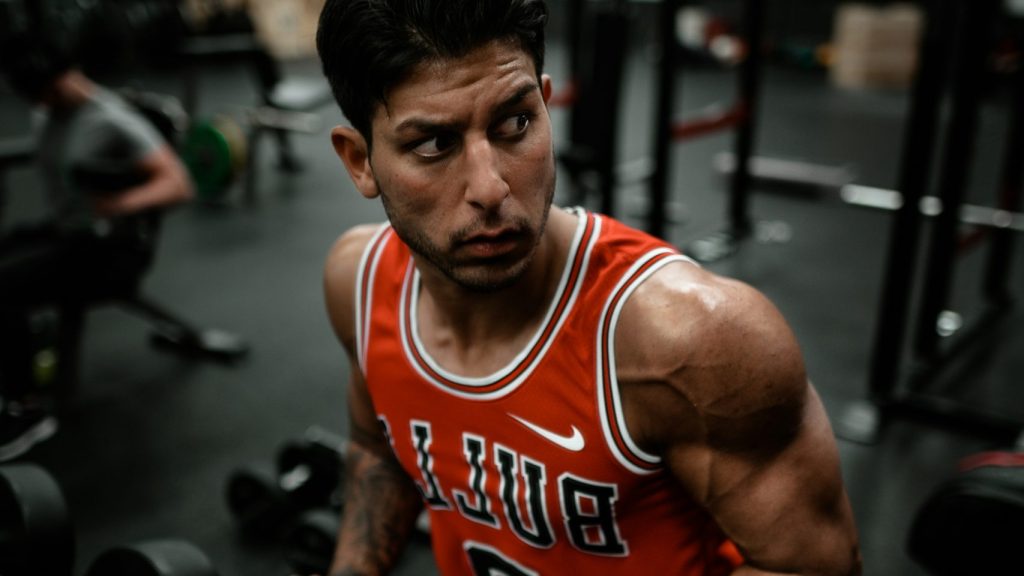
Conclusion: Enhancing Mobility Through Crossfit Exercises
This article has detailed the essential components of enhancing mobility through Crossfit, focusing on the importance of flexibility and strength and outlining methods to measure and improve these attributes continually. From foundational exercises to advanced tracking techniques, the guide provides actionable insights for athletes at every level, presenting a comprehensive approach to achieving and maintaining peak physical performance.
“Start integrating these mobility-enhancing exercises into your Crossfit routine today and experience the difference in your performance and flexibility. Remember, consistent effort and proper measurement are key to long-term success.”
Understanding Mobility in Crossfit
The discussion began by emphasizing the critical role of mobility in enhancing performance and reducing injury risk in Crossfit. It highlighted the necessity for athletes to have a thorough understanding of mobility’s fundamentals, allowing them to incorporate effective mobility workouts into their routines that extend beyond traditional stretching.
Top Crossfit Exercises to Improve Mobility
The article then provided insights into specific exercises and routines that effectively combine mobility improvements with strength training. This section offered detailed descriptions of how integrating movements like squats, lunges, and shoulder presses with mobility-focused drills contributes to comprehensive fitness regimens that enhance athletic performance and health.
The Role of Stretching in Crossfit Routines
Further, we outlined the importance of incorporating various types of stretching into Crossfit routines, discussing the optimal timing for dynamic and static stretching and how these practices can significantly benefit muscular health and workout effectiveness. This guidance helps athletes understand when and how to incorporate stretching to maximize the benefits of their workouts and maintain muscle health.
Crossfit Workouts for Flexibility and Strength
In the section on designing balanced Crossfit programs, we stressed the need for workouts that foster both strength and flexibility. Strategies for creating routines that ensure athletes develop robust and adaptable bodies capable of handling Crossfit demands without compromising flexibility or increasing injury risks were discussed.
Measuring Progress in Mobility with Crossfit
Lastly, we explored tools and strategies for tracking mobility progress, including the use of assessments and technology to set realistic goals and monitor improvements, supplemented by case studies illustrating successful strategies. This information is crucial for athletes who seek to not just achieve but maintain and build upon their mobility and fitness gains.
- Understanding Mobility: Critical for performance enhancement and injury prevention in Crossfit.
- Effective Exercises: Incorporating squats, lunges, and shoulder presses improves overall mobility.
- Role of Stretching: Timing and types of stretching are crucial for maximizing workout effectiveness.
- Balanced Workouts: Combining strength and flexibility in workouts fosters long-term fitness.
- Measuring Progress: Using assessments and setting realistic goals are vital for continuous improvement.
In summary, enhancing mobility through Crossfit exercises is a dynamic process that requires dedication, proper planning, and ongoing adjustments. The strategies and insights provided in this article are designed to help athletes not only achieve but also maintain optimal mobility and performance. Whether you are a beginner or a seasoned Crossfit enthusiast, these guidelines will assist in developing a more robust, flexible, and injury-resistant physique. Committing to a consistent regimen that includes thorough mobility assessments and tailored exercises will significantly enhance your Crossfit performance and overall well-being. Continue to explore additional resources and training methods to further enhance your mobility and overall Crossfit capabilities.